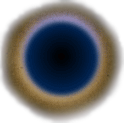The live performance and improvisatory basis of my early videos inevitably led to considerations of the nature of the feedback of sound, vision and emotional meaning that was taking place between the performers. This became in my mind coupled with the phenomenon of video feedback, where the result of pointing a camera at a monitor containing the displayed output of the camera results in an ever-receding image of what the camera is pointing at. In the most trivial case this is of course the monitor itself, but far more interesting things happen when there is tiny (or deliberately larger) random noise in the system. This easily results in a “tipping point” where the ordered “ever-receding image” breaks up into a more chaotic visual display, but is still usually controllable.
This was one of the most fruitful and creative aspects of working with the equipment I had access to, and when the feedback loop was “seeded” with other images or patterns (to create deliberate “noise” or other visual structures in the loop) it was immediately apparent that what was produced was quite complex imagery that often related to many natural forms. That sophisticated 20th century technical equipment could intrinsically, and almost instantaneously, produce forms mimicking nature was exciting and something I used creatively for nearly a decade, driven by delight and wonder rather than analytical understanding. I was led to an intuition that science and technology were not so separate from nature as was generally thought, and the ways I was working obviously led to an understanding that science, technology and art were deeply connected too.
These intuitions became verified over a decade later when mathematicians (particularly Benoit Mandelbrot), investigating complicated systems mathematically, arrived at a understanding of “chaos” and “complexity” and how those processes underlay the natural forms in nature around us. The feedback loop in video can be very ordered, as in the trivial case mentioned above, which is like the infinite reflections in two pieces of opposing mirrors (which are so “perfect” because there is no noise in the infinite reflections). But introduce any noise (chaos) into a video feedback loop and immediately video feedback becomes an instantaneous example of a complex phenomenon.
The use of feedback and the variety of forms that were possible became a strong inspiration and theme in my work. I also understood that order and chaos are just two sides of the same process of manifestation of form, often only appearing to be one or the other because of the fixed viewpoint, scale and perspective of the observer. This idea is apparently less understood by the mathematicians because it is essentially a subjective experience . . .
